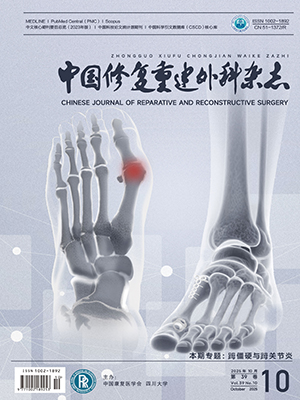Objective To evaluate the analgesic efficacy of ultrasound-guided high fascia iliaca compartment block (HFICB) in managing tourniquet-related pain following total knee arthroplasty (TKA). Methods A prospective randomized controlled trial was conducted involving 84 patients with severe knee osteoarthritis or rheumatoid arthritis who underwent unilateral TKA between March 2024 and December 2024. Patients were randomly assigned to two groups (n=42) using a random number table. In the trial group, ultrasound-guided HFICB was performed preoperatively, with 0.2% ropivacaine injected into the fascia iliaca compartment. No intervention was administered in the control group. Baseline characteristics, including gender, age, surgical side, body mass index, and preoperative visual analogue scale (VAS) scores at rest and during movement, showed no significant difference between the two groups (P>0.05). In both groups, a tourniquet was applied after osteotomy and before pulsed lavage, and removed after the closure of the first layer of the joint capsule. Postoperative assessments were conducted at 6, 12, 24, and 48 hours, including VAS scores at the tourniquet site (at rest and during movement), Bromage motor block scores, Ramsay sedation scores, and Bruggrmann comfort scale (BCS) scores to evaluate patient comfort. Additionally, the average tramadol consumption and incidence of nausea and vomiting within 48 hours postoperatively were recorded and compared. Results In the trial group and control group, VAS scores during movement at the tourniquet site significantly improved at all postoperative time points compared to preoperative levels (P<0.05). VAS scores at rest increased transiently at 6 hours after operation in both groups, and then gradually decreased to the preoperative level. Except that there was no significant difference at 48 hours after operation in the trial group (P>0.05), there were significant differences at other time points of two groups compared to preoperative score (P<0.05). Except for VAS score at rest at 6 hours, VAS score during movement at 48 hours, and BCS comfort score at 48 hours (P>0.05), the trial group showed significantly better outcomes than the control group in terms of VAS score at rest, VAS score during movement, Ramsay sedation scores, and BCS comfort scores at all other time points (P<0.05). No significant difference was found in Bromage motor block scores between the groups (P>0.05). Tramadol was used in 3 patients in the trial group and 7 patients in the control group within 48 hours after operation, the dosage was (133.30±14.19) mg and (172.40±22.29) mg, showing significant difference (P<0.05). Nausea and vomiting occurred in 4 patients (9.5%) in the trial group and 3 patients (7.1%) in the control group, with no significant difference in incidence between groups (P>0.05). Conclusion Ultrasound-guided HFICB provides effective analgesia for tourniquet-related pain following TKA, facilitates early postoperative functional recovery of the knee joint, and may serve as a valuable clinical option for postoperative pain management in TKA patients.
Citation:
YU Qingqing, TANG Yingchao, FU Haiyu, JIANG Li, SONG Benjing, WANG Wei, XIE Qingyun, CHEN Song. Observation on analgesic efficacy of ultrasound-guided high fascia iliac compartment block for tourniquet-related pain following total knee arthroplasty. Chinese Journal of Reparative and Reconstructive Surgery, 2025, 39(8): 1045-1050. doi: 10.7507/1002-1892.202505024
Copy
Copyright © the editorial department of Chinese Journal of Reparative and Reconstructive Surgery of West China Medical Publisher. All rights reserved




